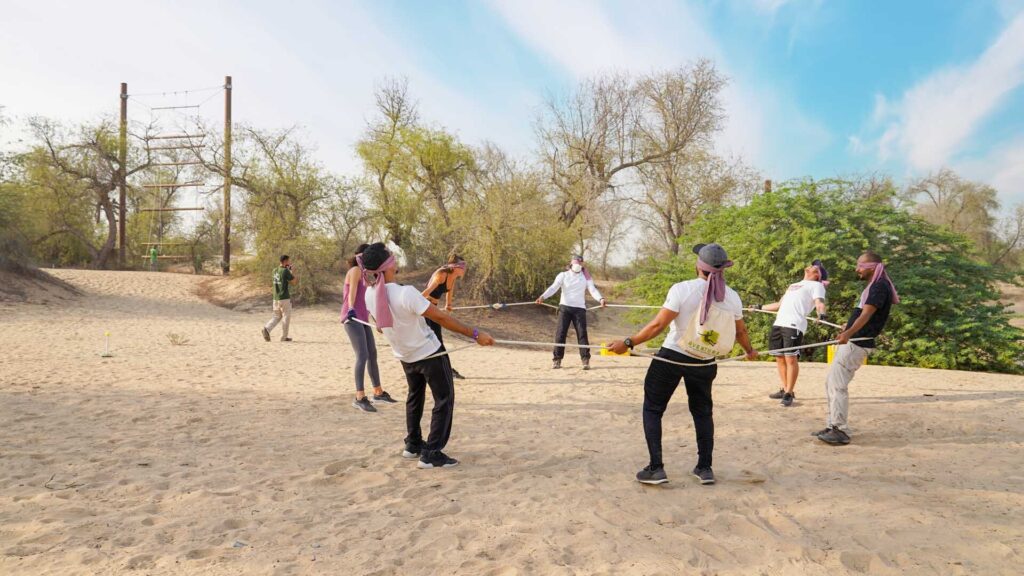Team Building Unleashed: Finding the Perfect Activities for Your Group

Fostering a cohesive, collaborative, and effective team is more crucial than ever. The perfect team-building activities, tailored to your group’s specific needs, can bridge communication gaps, forge connections, and catalyze productivity. Read on to unleash the power of team building, unveiling the activities best suited for your group.
Assessing Your Group’s Needs and Goals

At the core of every successful team-building initiative lies a deep understanding of the group’s requirements and objectives. Begin by identifying your team’s strengths and weaknesses. Are there communication barriers? Perhaps your crew excels at task delegation but struggles with conflict resolution. Pinpoint these areas to tailor-make the most efficient team building activities.
Dive into discussions with team members. A simple conversation can illuminate team dynamics and expose underlying issues. Encourage openness and solicit feedback. This insight will not only enhance team cohesion but also foster an environment where everyone feels heard and valued.
Remember, team-building isn’t one-size-fits-all. It’s an evolving journey that varies for every group. By being attuned to your team’s shifting dynamics, aspirations, and challenges, you can ensure that your team-building initiatives remain effective and relevant.
Types of Team Building Activities
There’s a vast universe of team-building activities out there, each designed to foster specific skills. Problem-solving activities, for instance, hone analytical and strategic thinking. On the other hand, trust-building exercises focus on cultivating a safe and supportive environment for team members.
Creative exercises can be a goldmine. They stimulate out-of-the-box thinking and inspire innovation. By tapping into everyone’s unique perspectives, these activities can unearth novel solutions and lead to enhanced teamwork.
Don’t be afraid to mix things up! Rotate between different types of exercises to ensure all areas of team development are covered. This way, your group remains engaged, and no single aspect of team growth is neglected.
Indoor vs. Outdoor Team Building Options

Selecting between indoor and outdoor activities can significantly influence the effectiveness of your team-building venture. Indoor activities, like board games or role-playing, offer a controlled environment and are often logistically simpler. They can be particularly useful when targeting specific skills or themes.
Outdoor exercises, like obstacle courses or treasure hunts, often demand physical exertion, fostering camaraderie and resilience. Nature’s expansive setting can be instrumental in breaking down formal barriers, encouraging informal interactions, and forging deeper connections.
While both indoor and outdoor activities have their merits, the ideal choice often hinges on your group’s preferences, goals, and logistical constraints. Strive for a balanced mix to keep things fresh and cater to diverse preferences within your group.
Customizing Activities for Your Team
Generic exercises might not always resonate with your team. Thus, personalization becomes key. Think of the bigger picture; how do the activities align with your company’s culture, values, and mission?
Take the demographic mix of your team into account. An age-diverse group might have varying preferences, and cultural backgrounds can play a significant role in determining what’s fun or acceptable.
Feedback loops are essential. Regularly solicit opinions on past activities, and make adjustments based on the input received. Being flexible and willing to adapt is the cornerstone of effective team building.
Facilitating Effective Sessions
Setting the stage for an effective session starts long before the activity begins. Start by establishing a positive and open environment. Set clear expectations, emphasizing the importance of mutual respect, understanding, and collaboration.
During the activity, keep an eye out for team dynamics. Encourage quieter members to speak up and ensure that everyone gets a chance to contribute. If conflicts arise, address them constructively, turning them into learning opportunities.
Post-activity, gather everyone for a debrief. Discuss the exercise’s outcomes, the challenges faced, and the lessons learned. This reflection phase is crucial, turning every team-building session into a learning experience.
Evaluating the Impact of Team Building

Post-event reflection isn’t just for participants; it’s a critical phase for facilitators too. Evaluate the success of the activity in terms of achieving set goals, be it improved communication, increased trust, or enhanced collaboration.
One effective way to gauge impact is through feedback. Use anonymous surveys or feedback forms to capture honest opinions. Look for patterns in the responses to identify areas of improvement.
Comparative assessments can be enlightening. Measure team performance before and after the activity. If there’s a noticeable uptick in productivity, morale, or any other targeted area, you’re on the right track!
Budgeting for Team Building Activities
While the benefits of team building are undeniable, it’s crucial to strike a balance between desired outcomes and budgetary constraints. Not all effective activities require hefty investments. In fact, simple, low-cost exercises can often yield impressive results.
Consider factors like location, equipment, and facilitator fees when budgeting. Sometimes, a shift in venue or slight modifications can lead to significant savings without compromising on the experience.
Finally, always factor in a contingency amount. Unexpected expenses can arise, and it’s always wise to be prepared.
Popular Activities and Games
There’s a plethora of popular team-building games out there, each offering unique benefits. Escape rooms, for instance, are fantastic for enhancing problem-solving skills and teamwork. Trivia quizzes can boost general knowledge while encouraging friendly competition.
Group projects, like constructing a bridge using limited materials, can foster creativity and collaboration. Meanwhile, games like “Two Truths and a Lie” can be instrumental in breaking the ice and fostering personal connections.
While these are some popular options, always keep an ear to the ground. New and innovative games are continually emerging, each offering fresh and exciting team-building opportunities.
Remote and Virtual

With the rise of remote work, virtual team building has surged in importance. Virtual escape rooms, online quizzes, and collaborative projects on platforms like Trello or Notion are reshaping how we perceive team building.
Remote coffee breaks or virtual happy hours can be a great way to foster informal interactions. For those missing the face-to-face element, tools like Zoom or Microsoft Teams can simulate a real-world experience.
Challenges unique to remote teams, like time zone differences or technical glitches, can arise. Yet, with planning and flexibility, virtual team building can be just as effective, if not more, than its real-world counterpart.
Final Thoughts
Harnessing the power of team building is a dynamic journey, brimming with challenges and rewards. While the landscape of team-building activities is vast and ever-evolving, the core principle remains: fostering understanding, collaboration, and unity within a group. By tuning into your team’s unique needs, experimenting with various activities, and embracing feedback, you can unleash unparalleled teamwork, driving your group to new heights of success.




